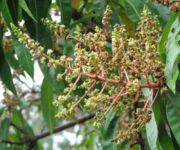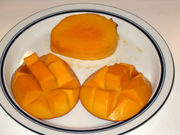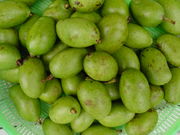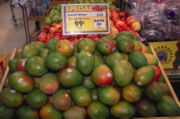Mango
2007 Schools Wikipedia Selection. Related subjects: Food and agriculture; Plants
| iMango | ||||||||||||
|---|---|---|---|---|---|---|---|---|---|---|---|---|
 Immature Black Mango fruit
|
||||||||||||
| Scientific classification | ||||||||||||
|
||||||||||||
|
|
||||||||||||
|
About 35 species, including: |
The mango (plural mangos or mangoes) is a tropical fruit of the Mango tree. Mangoes belong to the genus Mangifera which consists of about 35 species of tropical fruiting trees in the flowering plant family Anacardiaceae. No one knows the exact origins of the mango but most believe that it is native to the Southern and Southeast Asian continent including Eastern India, Burma, and Bangladesh after fossil records were found there dating back 25 to 30 million years. Reference to mangos as the "food of the gods" can be found in the Hindu Vedas.
Etymology
The name of the fruit comes from the Tamil word maanga , or the Malayalam word manga , and popularised by the Portuguese after their Indian exploration, hence the word 'manga' in Portuguese.
Description
Mangos are large trees, reaching 35-40 m in height, with a crown radius of 10 m. The leaves are evergreen, alternate, simple, 15-35 cm long and 6-16 cm broad; when young they are orange-pink, rapidly changing to a dark glossy red, then dark green as they mature. The flowers are produced in terminal panicles 10-40 cm long; each flower is small and white with five petals 5-10 mm long, with a mild sweet odour suggestive of lily of the valley. After the flowers finish, the fruit takes from three to six months to ripen.
The mango fruit is a drupe; when mature, it hangs from the tree on long stems. They are variable in size, from 10-25 cm long and 7-12 cm diameter, and may weigh up to 2.5 kg. The ripe fruit is variably coloured yellow, orange and red, reddest on the side facing the sun and yellow where shaded; green usually indicates that the fruit is not yet ripe, but this depends on the cultivar. When ripe, the unpeeled fruit gives off a distinctive resinous slightly sweet smell. In the centre of the fruit is a single flat, oblong seed (as big as a large stone) that can be fibrous or hairless on the surface, depending on cultivar. Inside the shell, which is 1-2 mm thick, is a paper-thin lining covering a single seed, 4-7 cm long, 3-4 cm wide, 1 cm thick.
Cultivation and uses
The mango is now widely cultivated as a fruit tree in frost-free tropical and subtropical climates throughout the Indian subcontinent, North, South and Central America, the Caribbean, south and central Africa, Australia and Southeast Asia. It is easily cultivated and there are now more than 1,000 cultivars, ranging from the turpentine mango (from the strong taste of turpentine, which according to the Oxford Companion to Food some varieties actually contain) to the huevos de toro ("bull's balls", from the shape and size). The mango is reputed to be the most commonly eaten fresh fruit worldwide. Mangos also readily naturalize in tropical climates. Some lowland forests in the Hawaiian Islands are dominated by introduced mangos and it is a common backyard fruit tree in South Florida where it has also escaped from cultivation.
The mango is a popular fruit with people around the world. However, many mango farmers receive a low price for their produce. This has led to mangoes being available as a ' fair trade' item in some countries.
Usage as food
The fruit flesh of a ripe mango contains about 15% sugar, up to 1% protein, and significant amounts of vitamins A, B and C. The taste of the fruit is very sweet, with some cultivars having a slight acidic tang. The texture of the flesh varies markedly between different cultivars; some have quite a soft and pulpy texture similar to an over-ripe plum, while others have a firmer flesh much like that of a cantaloupe or avocado, and in some cultivars the flesh can contain fibrous material. Mangoes are very juicy; the sweet taste and high water content make them refreshing to eat, though somewhat messy.
Mangoes are widely used in chutney, which in the West is often very sweet, but in the Indian subcontinent is usually sharpened with hot chilis or limes. In India, ripe mango is often cut into thin layers, desiccated , folded, and then cut and sold as bars that are very chewy. These bars, known as amavat in Hindi, are similar to dried guava fruit bars available in Colombia. Many people like to eat unripe mangoes with salt (which are extremely sour; much more than lemon), and in regions where food is hotter, with salt and chili.
In the Philippines, unripe mango is eaten with bagoong, fermented minute shrimp paste which comes in sweet, salty and spicy flavours. Dried strips of sweet, ripe mangoes have also gained popularity both inside and outside the country, with those produced in Cebu making it to export markets around the world.
Mango is also used to make juices, both in ripe and unripe form. Pieces of fruit can be mashed and used in ice cream; they can be substituted for peaches in a peach (now mango) pie; or put in a blender with milk, a little sugar, and crushed ice for a refreshing beverage. A more traditional Indian drink is mango lassi, which is similar, but uses a mixture of yoghurt and milk as the base, and is sometimes flavoured with salt or cardamom. In Thailand and other South East Asian countries, sweet glutinous rice is flavoured with coconut then served with sliced mango on top as a dessert.
Dried unripe mango used as a spice in India is known as amchur (sometimes spelled amchoor). Am is a Hindi word for Mango and amchoor is nothing but powder or extract of Mango.
Note: The Sweet Bell Pepper ( capsicum) was once known as mango in parts of the midwestern United States Merriam-Webster Dictionary Definition. With the advent of fresh fruit importers exposing individuals to the tropical fruit, the colloquial use of this alternative name for the Sweet Bell Pepper has become archaic, although occasionally midwestern menus will still offer stuffed mangoes as an entree.
Medicinal properties
The mango is in the same family as poison ivy and contains urushiol, though much less than poison ivy. Some people get dermatitis from touching mango peel or sap. Persons showing an allergic reaction after handling a mango can usually enjoy the fruit if someone else first removes the skin. The leaves are toxic to cattle.
Cultural context
Mango leaves are used to decorate the entrance of a household amongst Hindus. Mango leaves are also used in Indian prayers ( poojas) to propitiate the Gods. The mango is also a common motif in Indian textiles, known as the paisley design.
Production and consumption
| Top 12 Mango Producers - 2005 (hectares) |
|
|---|---|
| 1,600,000 | |
| 433,600 | |
| 285,000 | |
| 273,440 | |
| 173,837 | |
| 160,000 | |
| 151,500 | |
| 125,000 | |
| 82,000 | |
| 68,000 | |
| 53,000 | |
| 51,000 | |
| World Total | 3,870,200 |
| Source: UN Food & Agriculture Organisation (FAO) |
|
As of 2005 India was the largest producer, with an area of 16,000 km² with an annual production of 10.8 million tonnes, which accounted for 57.18% of the total world production. The state of Maharashtra in western India has the most conducive climate conditions to produce the most renowned variety of this fruit, the Hapoos mango. The earlier Portuguese explorers took to calling it Aphoos and later, Alphonso. Farmers in the entire coastal Konkan belt cultivate the Hapoos mango, which fetches them substantial profits. The Ratnagiri and Devgad Hapoos from Maharashtra jointly take place of pride as the finest amongst all types of mangoes produced. Otherwise, the state of Uttar Pradesh dominates the mango production in the North, and it is considered the most important fruit in central and eastern part of the state, from Lucknow to Varanasi, which also produce some fine varieties. In southern India, Andhra Pradesh and Karnataka states are major producers of mangoes and specialize in making a variety of mango pickles. These pickles are very spicy. It is almost an essential food in Andhra families, where mango pickle production is a household activity in summer.
Generally, once ripe, mangoes are quite juicy and can be very messy to eat. However, those exported to temperate regions are, like most tropical fruit, picked under-ripe. Although they are ethylene producers and ripen in transit, they do not have the same juiciness or flavour as the fresh fruit. A ripe mango will have an orange-yellow or reddish skin. To allow a mango to continue to ripen after purchase, it should be stored in a cool, dark place, but not in a refrigerator as this will slow the ripening process.
Ripe mangoes are extremely popular throughout Latin America. In Mexico, sliced mango is eaten with chili powder and/or salt. Street vendors sometimes sell whole mangoes on a stick, dipped in the chili-salt mixture. In Indonesia, green mango is sold by street vendors with sugar and salt and/or chili. Green mango may be used in the sour salad called rujak in Indonesia, and rojak in Malaysia and Singapore. In Guatemala, Ecuador, Nicaragua and Honduras, small, green mangoes are popular; they have a sharp, brisk flavour like a Granny Smith apple. Vendors sell slices of peeled green mango on the streets of these countries, often served with salt. In Hawai'i it is common to pickle green mango slices.
Cultivars
Many hundred named mango cultivars exist. In mango orchards, several cultivars are often intermixed to improve cross-pollination. In Maharashtra, the most common cultivar is ' Alphonso' (locally called 'Aphoos'). 'Alphonso' is known as the King of Mangoes due to the popular opinion among many in India that it is the best cultivar available. The best 'Alphonso' mangos are reputed to come from the town of Ratnagiri and Devgad in Maharashtra. In Uttar Pradesh, ' Dasheri' from Lucknow is famous for its aroma, and is so tasty that even the skin can be eaten. 'Langada' from Varanasi in eastern UP is another variety which is extremely sought after for its fine flavour and aroma. ' Banganapalli' (also called 'Banesha' or 'Began Phali') of Andhra Pradesh is one of the most sought after cultivar. Maldah is one of the most sought after cultivar in Bihar. Notably, cultivars which excel in one climate fail to achieve their potential in other climates. Thus the cultivar 'Julie', a Jamaican favourite, and 'Alphonso' have never found great success in South Florida, Israel or Australia.
Currently, the world market is dominated by the cultivar 'Tommy Atkins'- a seedling of 'Haden' which first fruited in 1940 in Southern Florida, USA. Despite being initially rejected commercially by Florida researchers, 'Tommy Atkins' quickly became an export favourite worldwide. For example, 80% of mangos in UK supermarkets are ' Tommy Atkins'. The success of 'Tommy Atkins' comes despite its fiberous flesh and fair taste. Despite this, growers world-wide have embraced the cultivar for its exceptional production and disease resistant, the shelf-life of its fruit, their transportability as well as their size and beautiful colour. 'Tommy Atkins' is predominant in the USA as well, although other cultivars, such 'Kent', 'Keitt', the Haitian grown 'Madame Francis' and the Mexican grown 'Champagne' are widely available.
In urban areas of southern Florida, small gardens, or lack thereof, have fueled the desire for dwarf Mango trees. The Fairchild Tropical Botanic Garden has led the charge for the "condo mango" by identifying cultivars which can be productive while maintained at a height below 2-2.5 m .
A list of additional leading cultivars can be found at the cultivar list link in the external links below.





